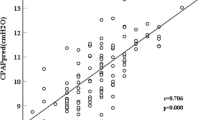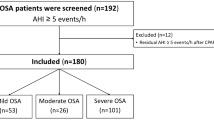Abstract
Background
Race/ethnicity may play an important role in determining body size, severity of obstructive sleep apnea syndrome (OSAS), and effective continuous positive airway pressure (CPAP) (Peff). Turkey is composed of different ethnic groups. Therefore, the aims of this study were to determine new prediction formula for CPAP (Ppred) in Turkish OSAS patients, validate performance of this formula, and compare with Caucasian and Asian formulas.
Methods
Peff of 250 newly diagnosed moderate-to-severe OSAS patients were calculated by in-laboratory manual titration. Correlation and multiple linear regression analysis were used to model effects of ten anthropometric and polysomnographic variables such as neck circumference (NC) and oxygen desaturation index (ODI) on Peff. New formula was validated in different 130 OSAS patients and compared with previous formulas.
Results
The final prediction formula was \( {\text{Ppred}} = \left( {0.{148} \times {\text{NC}}} \right) + \left( {0.0{38} \times {\text{ODI}}} \right) \). When Peff of control group was assessed, it was observed that mean Peff was 8.39 ± 2.00 cmH2O and Ppred was 8.23 ± 1.22 cmH2O. Ppred was within ±3 cmH2O of Peff in 96.2% patients. Besides, Peff was significantly correlated with new formula, and prediction formulas developed for Caucasian and Asian populations (r = 0.651, p < 0.001, r = 0.648, p < 0.001, and r = 0.622, p < 0.001, respectively).
Conclusions
It is shown that level of CPAP can be successfully predicted from our prediction formula, using NC and ODI and validated in Turkish OSAS patients. New equation correlates with other formulas developed for Caucasian and Asian populations. Our simple formula including ODI, marker of intermittent hypoxia, may be used easily in different populations.

Similar content being viewed by others
References
Young T, Palta M, Dempsey J, Skatrud J, Weber S, Badr S (1993) The occurrence of sleep-disordered breathing among middle-aged adults. N Engl J Med 328:1230–1235
Selim B, Won C, Yaggi HK (2010) Cardiovascular consequences of sleep apnea. Clin Chest Med 31:203–220
Jennum P, Riha RL (2009) Epidemiology of sleep apnoea/hypopnoea syndrome and sleep-disordered breathing. Eur Respir J 33:907–914
Gordon P, Sanders MH (2005) Positive airway pressure therapy for obstructive sleep apnoea/hypopnoea syndrome. Thorax 60:68–75
Yaggi HK, Strohl KP (2010) Adult obstructive sleep apnea/hypopnea syndrome: definitions, risk factors, and pathogenesis. Clin Chest Med 31:179–186
Freedman N (2010) Treatment of obstructive sleep apnea syndrome. Clin Chest Med 31:187–201
Oliver Z, Hoffstein V (2000) Predicting effective continuous positive airway pressure. Chest 117:1061–1064
Hertegonne KB, Volna J, Portier S, De Pauw R, Van Maele G, Pevernagie DA (2008) Titration procedures for nasal CPAP: automatic CPAP or prediction formula? Sleep Med 9:732–738
El Solh AA, Aldik Z, Alnabhan M, Grant B (2007) Predicting effective continuous positive airway pressure in sleep apnea using an artificial neural network. Sleep Med 8:471–477
Miljeteig H, Hoffstein V (1993) Determinants of continuous positive airway pressure level for treatment of obstructive sleep apnea. Am Rev Respir Dis 147:1526–1530
Stradling JR, Hardinge M, Paxton J, Smith DM (2004) Relative accuracy of algorithm-based prescription of nasal CPAP in OSA. Respir Med 98:152–154
Sériès F (2000) Accuracy of an unattended home CPAP titration in the treatment of obstructive sleep apnea. Am J Respir Crit Care Med 162:94–97
Loredo JS, Berry C, Nelesen RA, Dimsdale JE (2007) Prediction of continuous positive airway pressure in obstructive sleep apnea. Sleep Breath 11:45–51
Schiza SE, Bouloukaki I, Mermigkis C, Panagou P, Tzanakis N, Moniaki V, Tzortzaki E, Siafakas NM (2010) Utility of formulas predicting the optimal nasal continuous positive airway pressure in a Greek population. Sleep Breath 15:417–423.
Lin IF, Chuang ML, Liao YF, Chen NH, Li HY (2003) Predicting effective continuous positive airway pressure in Taiwanese patients with obstructive sleep apnea syndrome. J Formos Med Assoc 102:215–221
Rowley JA, Tarbichi AG, Badr MS (2005) The use of a predicted CPAP equation improves CPAP titration success. Sleep Breath 9:26–32
Lacedonia D, Sabato R, Carpagnano GE, Carratù P, Falcone A, Gadaleta F, Resta O, Foschino Barbaro MP (2011) Predictive equations for CPAP titration in OSAS patients. Sleep Breath Jan 6 [Epub ahead of print].
Masa JF, Jiménez A, Durán J, Capote F, Monasterio C, Mayos M, Terán J, Hernández L, Barbé F, Maimó A, Rubio M, Montserrat JM (2004) Alternative methods of titrating continuous positive airway pressure: a large multicenter study. Am J Respir Crit Care Med 170:1218–1224
Lee RW, Vasudavan S, Hui DS, Prvan T, Petocz P, Darendeliler MA, Cistulli PA (2010) Differences in craniofacial structures and obesity in Caucasian and Chinese patients with obstructive sleep apnea. Sleep 33:1075–1080
Villaneuva AT, Buchanan PR, Yee BJ, Grunstein RR (2005) Ethnicity and obstructive sleep apnoea. Sleep Med Rev 9:419–436
Yamagishi K, Ohira T, Nakano H, Bielinski SJ, Sakurai S, Imano H, Kiyama M, Kitamura A, Sato S, Konishi M, Shahar E, Folsom AR, Iso H, Tanigawa T (2010) Cross-cultural comparison of the sleep-disordered breathing prevalence among Americans and Japanese. Eur Respir J 36:379–384
Bouloukaki I, Kapsimalis F, Mermigkis C, Kryger M, Tzanakis N, Panagou P, Moniaki V, Vlachaki EM, Varouchakis G, Siafakas NM, Schiza SE (2010) Prediction of obstructive sleep apnea syndrome in a large Greek population. Sleep Breath Sep 25 [Epub ahead of print].
Izci B, Ardic S, Firat H, Sahin A, Altinors M, Karacan I (2008) Reliability and validity studies of the Turkish version of the Epworth Sleepiness Scale. Sleep Breath 12:161–168
Johns MW (1991) A new method for measuring daytime sleepiness: the Epworth sleepiness scale. Sleep 14:540–545
Rechtschaffen A, Kales A (1968) A manual of standardized terminology, techniques and scoring system for sleep stages of human subjects. Brain Information Service/Brain Research Institute, University of California at Los Angeles
Iber C, Ancoli-Israel S, Chesson AL, Quan SF, for the American Academy of Sleep Medicine (2007) The AASM manual 2007 for the scoring of sleep and associated events: rules, terminology and technical specifications. American Academy of Sleep Medicine, Westchester
American Academy of Sleep Medicine (2005) International classification of sleep disorders, 2nd edition: diagnostic and coding manual. American Academy of Sleep Medicine, Westchester
Sleep-related breathing disorders in adults: recommendations for syndrome definition and measurement techniques in clinical research. The report of an American Academy of Sleep Medicine Task Force (1999). Sleep 22:667-689
Kushida CA, Chediak A, Berry RB, Brown LK, Gozal D, Iber C, Parthasarathy S, Quan SF, Rowley JA, Positive Airway Pressure Titration Task Force; American Academy of Sleep Medicine (2008) Clinical guidelines for the manual titration of positive airway pressure in patients with obstructive sleep apnea. J Clin Sleep Med 4:157–171
Hoffstein V, Mateika S (1994) Predicting nasal continuous positive airway pressure. Am J Respir Med 150:486–488
Comas D, Calafell F, Mateu E, Pe’rez-Lezaun A, Bertranpetit J (1996) Geographic variation in human mitochondrial DNA control region sequence: the population history of Turkey and its relationship to the European populations. Mol Biol Evol 13:1067–1077
Conflict of interest
The authors declare that they have no conflicts of interest.
Author information
Authors and Affiliations
Corresponding author
Additional information
The manuscript was presented as an abstract at Sleep and Breathing Conference 2011, Prague.
Rights and permissions
About this article
Cite this article
Basoglu, O.K., Tasbakan, M.S. Determination of new prediction formula for nasal continuous positive airway pressure in Turkish patients with obstructive sleep apnea syndrome. Sleep Breath 16, 1121–1127 (2012). https://doi.org/10.1007/s11325-011-0612-z
Received:
Revised:
Accepted:
Published:
Issue Date:
DOI: https://doi.org/10.1007/s11325-011-0612-z




